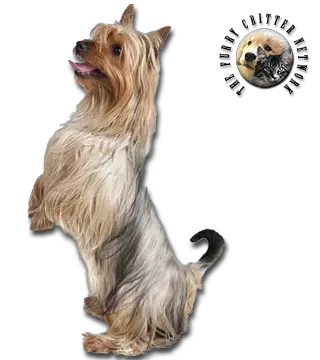Breed Standard
Head: Strong and of moderate length. Flat skull. Strong jaws. Tight lips.
Ears: Small, V-shaped, thin leather. Set high on the head and carried erect.
Eyes: Small, round. Color as dark as possible.
Body: Moderately long. Deep, moderately wide chest. Strong loin. Straight back.
Tail: Cropped and carried straight.
Hair: Fine and silky. 13 to 15 cm (5-6 in) long from behind the ears to the base of the tail. Lower legs are free of long hair.
Coat: Blue and tan or gray-blue and tan. Blue on the tail must be dark. Gray-blue has tan tufts at the base of the ear, on the muzzle and sides of the face. Blue extends from the base of the skull to the tip of the tail and down the legs to the knees and hocks. Tan markings on the feet and under the tail.
Size: Approx. 22,5 cm (9 in).
Weight: 3,5 to 4,5 kg (8-10 lb).
History
The ancestors of the Australian Silky Terrier include the Yorkshire Terrier and the Australian Terrier (which descends from the rough coated type terriers brought from Great Britain to Australia in the early 19th century); few records indicate whether early dogs were just Australian Terriers born with silky fur, or whether there was an attempt to create a separate breed. According to the American Kennel Club, the breed was created at the end of the 19th century when Yorkshire Terriers were crossed with Australian Terriers. At first the breed was known as the Sydney Silky, as it was found primarily in the city of Sydney, Australia. Although most other Australian breeds were working dogs, the Silky Terrier was bred primarily to be an urban pet and companion, although it is also known for killing snakes in Australia.
Up until 1929 the Australian Terrier, the Australian Silky Terrier, and the Yorkshire Terrier were not clearly defined. Dogs of three different breeds might be born in the same litter, to be separated by appearance into the different types once they were grown. After 1932 in Australia, further crossbreeding was discouraged, and in 1955 the breed's name officially became the Australian Silky Terrier. The breed was recognised by the Australian National Kennel Council in 1958 in the Toy Group.
During and after World War II American servicemen who had been stationed in Australia brought back to the United States a few Silky Terriers. Newspaper photographs of the breed in 1954 caused an upsurge of popularity and hundreds of Silkies were imported from Australia to the United States. The American Kennel Club recognised the breed as the Silky Terrier in 1959, as did the United Kennel Club (US) in 1965 where it is shown as a Terrier; it is also recognised as the Silky Terrier by the Canadian Kennel Club. The breed is recognised by all the major kennel clubs in the English speaking world, and internationally by the Fédération Cynologique Internationale as breed number 236. It may also be recognized by various minor kennel clubs and internet breed registry businesses.
The Australian Silky Terrier is a terrier, but is usually placed in the Toy Group rather than the Terrier Group due to its small size. As breed groupings are done mostly to organise groups of breeds for dog shows, it is safer for the little dogs to be with others their own size, rather than with larger dogs. The Fédération Cynologique Internationale has a special section of the Terrier Group that includes only the smallest dogs, while other kennel clubs place the breed in the Toy Group, but it is universally agreed that the breed's type is Terrier.
Behavior
This loving, little terrier is very intelligent, courageous and alert. Affectionate, spunky, cheerful and sociable, they like to be close to their master. They are full of energy and need a good amount of exercise in order to be calm. Curious and keen they are an enthusiastic digger. Active, smart and quick. Despite their size, this docile dog makes a good watchdog. This is a sturdy breed that adjusts well to traveling. They are not generally trustworthy with other non-canine pets such as rabbits, hamsters and guinea pigs. Socialize them well including with cats so they do not chase them. Good with children so long as the dog does not have a meek owner who fails to give him the discipline and structure all dogs instinctually need. Training these dogs is very straight- forward because it is very eager to learn. Do not allow this little dog to develop Small Dog Syndrome, human induced behaviors where the dog believes he is pack leader to humans. When a Silky believes they are the boss, their temperament changes, as they try to control everyone and every thing around them. They may become demanding, willful, protective and may begin to bark a lot. They may begin to be untrustworthy with children and sometimes adults, becoming snappish if peeved and may pick fights with other dogs.
This very clean breed is well suited for life as a house dog provided he gets out often for long walks. Regular brushing and combing are required. This is not a dog to leave fenced in a yard. They need to be indoors and definitely do not need to be tied up outside, because they want attention so bad they might get hurt trying to get loose.
Function
Watchdog, Pet.
Health
Generally healthy. Minor concerns are intervertebral disc disease, elbow dysplasia, patellar luxation and Legg-Perthes. This breed sometimes is afflicted with diabetes, epilepsy, tracheal collapse.






